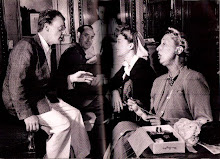
3.jpg) I just recently watched the 1939 James Cagney movie The Roaring Twenties (sorry it took me a while before writing it), and it was very dramatic. James Cagney was great as Eddie Bartlett, the former World War I veteran/cab driver who goes from being a big shot Prohibition-era bootlegging gangster to a poor, disheveled drunkard bum. (For those of you who are Simpsons fan, you gotta admit that the last name Bartlett is pretty sweet.)
I just recently watched the 1939 James Cagney movie The Roaring Twenties (sorry it took me a while before writing it), and it was very dramatic. James Cagney was great as Eddie Bartlett, the former World War I veteran/cab driver who goes from being a big shot Prohibition-era bootlegging gangster to a poor, disheveled drunkard bum. (For those of you who are Simpsons fan, you gotta admit that the last name Bartlett is pretty sweet.)

Characters in The Roaring Twenties were based loosely on actual Prohibition-era personalities, such as nightclub hostess Texas Guinan ("Hello, sucker!" was her refrain to club patrons) and New York gangster Larry Fay, who was reportedly the model for the literary character Jay Gatsby.) Incorporating newsreel clips and popular music from the period, and a voiceover by an omniscient reporter who assures the audience that what theyare about to see is based on true events, The Roaring Twenties has something of a pseudo-documentary feel.

Humphrey Bogart was also terrific in this film; two years later, he would get his famous big break in his role as detective Sam Spade in the film The Maltese Falcon—which is another film that I had to watch in film class—and in his role as a gangster on the lam in High Sierra (the character's name in that movie escapes me at the moment). This was Cagney and Bogie's last film together; the other films they made together were Angels with Dirty Faces—which was made the year before—and The Oklahoma Kid.

Cagney found that the freedom to improvise that Walsh allowed him helped boost the script into an above-average genre film. Cagney recalled the collaborative atmosphere on the set, remembering how one actor, Frank McHugh (who was back as Cagney's faithful sidekick), suggested a different opening scenario than the one provided in the script. All agreed to trash the opening scene and go with McHugh's suggestion, thus providing the irreverent banter between Cagney and Bogart, who meet as doughboys in a World War I foxhole.
Cagney reminisced later about the little touches that he felt "added flavor to bland writing," including the addition of the hilarious exchange between his character and Priscilla Lane's, in which his advances are turned down in humiliating fashion. In another scene, Cagney spiced up a run-of-the-mill fight by positioning one opponent to accidentally hit another adversary after being punched by Cagney's character. The film also benefits from an able supporting cast -- notably Gladys George (who inherited the part from Ann Sheridan) as the Texas Guinan character, plus McHugh and Lane, as Cagney's romantic interest.
.jpg)

.jpg)

I didn't really watch the shooting scenes in this film because I thought they were too dramatic. And I didn't feel sorry for Cagney when Priscilla Lane dumped him and went for Jeffrey Lynn instead; he didn't deserve her. (And there is an awkward scene where Lane climbs into Cagney's cab years later and she tells him about her present life while he just grunts in reponse because he doesn't forgive her for dumping him years ago. What an awkward reunion!) And the ship scene, where Cagney and his gang are trying to bootleg liquor, in this film reminded me of a scene in a Simpsons episode (which is on a post on my Simpsons blogpost) where Homer, Bart, and a group led by Mr. Burns travel to an island holding sugar to smuggle it into Springfield after Marge declares a war against sugar products when the city is declared "America's Fattest Town!" by a world records book.
 The film did extremely good at the box office and Cagney won a Best Actor award from the National Board of Review -- quite an accomplishment in a year that saw the premieres of such classics as Gone With the Wind, Mr. Smith Goes To Washington, and Stagecoach.
The film did extremely good at the box office and Cagney won a Best Actor award from the National Board of Review -- quite an accomplishment in a year that saw the premieres of such classics as Gone With the Wind, Mr. Smith Goes To Washington, and Stagecoach. The Roaring Twenties turned out to be a transitional film in Cagney's career; his subsequent roles during the 1940s would focus on his song-and-dance talents in such movies as Yankee Doodle Dandy (1942). Walsh would work with Bogart again in They Drive By Night (1940) and High Sierra (1941), in which Bogart started to create the world-weary character that would be most identified with the Bogie legend. Ten years after The Roaring Twenties, Cagney would reunite with Walsh for White Heat (1949), in which he would revive the gangster character that put him on the map. (And as an end-of-the-year present for you folks, I'll probably do a review blog on that film. ) I would recommend this film for James Cagney fans who love to see the guy in gangster films. And again, folks, happy commenting!!!
The Roaring Twenties turned out to be a transitional film in Cagney's career; his subsequent roles during the 1940s would focus on his song-and-dance talents in such movies as Yankee Doodle Dandy (1942). Walsh would work with Bogart again in They Drive By Night (1940) and High Sierra (1941), in which Bogart started to create the world-weary character that would be most identified with the Bogie legend. Ten years after The Roaring Twenties, Cagney would reunite with Walsh for White Heat (1949), in which he would revive the gangster character that put him on the map. (And as an end-of-the-year present for you folks, I'll probably do a review blog on that film. ) I would recommend this film for James Cagney fans who love to see the guy in gangster films. And again, folks, happy commenting!!!(Next blog: Yankee Doodle Dandy [1942])


Clips from The Roaring Twenties:












No comments:
Post a Comment